From the meats, vegetables, and noodles to the stove set up. Here’s a guide to cooking hot pot at home with friends for the ultimate winter get-together with friends or housemates.

The Hot Pot Tradition
When I was a kid in Hong Kong, as soon as the temperature even grazes 10 degrees, I’d be asked to dust off the gas canisters, fetch the portable stove, and find the big bundle of stainless steel strainer scoops from the back of the drawer, because… it’s hot pot season, baby!
Hot Pots are a big deal in my family. It embodies everything I love: A huge variety of food in one meal; delicious flavours that develop and intensify as the meal goes on; an excuse to discover great wine – and most of all – a come-one-come-all philosophy that gathers everyone you love to catch up and gas about nothing and everything at the same time.
As a kid, I learnt more about the ups and downs of life listening to my family and friends around the hot pot than from any class or novel.
Hot pot is the great equaliser.
Whether you’re usually the stern grandfather, the quiet child, or your brother’s new work friend we’ve never met before – everyone is united and warmed by the feast, and all are welcome at the table. Everyone gets a say on what ingredients should be included, everyone cooks together, laughs together, and the barriers thaw as soon as the first frozen meats hit the bubbling broth. Drooling yet? Read on.
Hot Pot, like life, is about having FUN
Some of my fondest memories and strongest friendships are made around the hot pot.
If you’re new to the tradition, welcome. It may seem overwhelming at first – between the soup bases, the dipping sauces, the frozen meats, the fish balls… there are literally millions of possible combinations.
But fear not, because your guide here is a seasoned pro. If you take nothing else from this article, this is the golden rule: hot pot, like life, is about having FUN. Follow your tastebuds, experiment, and if it goes wrong, it’s just one bite. There is always something else to try, and another surprise in your next dip of the hot pot that may just be the most delicious thing you’ve ever tasted. See? A meal and a life lesson.
With that in mind, there are a few guidelines that will help lay the groundwork to discover your own favourite combinations and start your own traditions.
Are you ready to have some fun?
The Setup For Hot Pot
Let’s start with the most important thing: the number of people. You can of course have a hot pot with one or two people. But to get the full experience, a bigger group is always better. More variety, more chat.
Aim for 4 or 5 people per pot and 8 is always my magic number. There’s enough for two pots and enough variety so you can have a bit of everything. That’s why cooking a hot pot is perfect for a night with friends or your housemates.
What you’re going to need…
When it comes to gear, Hot pot does require some equipment and set up. But it’s pretty inexpensive and everything lasts several lifetimes. Many Chinese families will have had a hot pot set that’s been around for generations, or get shared around when the kids move out of home.
The star of the show is, of course, the pot itself. You want a wide stock pot (no handles, that’s always dangerous in the heat of the moment). That’s deep enough to hold enough soup and ingredients and still have room to cook on the top layer. For a 4-person sized pot, typically aim for a 28cm or 30cm wide pot.
Chilli or No chili?
If some of your party are chilli fans while some are chilli shy. There are pots that come with a divider in the middle that allows you to have two soup bases in one pot. More on that later.
Part and parcel with the pot is the stove. These portable stoves are usually powered by gas canisters. So make sure you have plenty on hand – nothing kills a party faster than running out of gas. To avoid stress, there are also electric stoves and stock pots too. So find a set that works for you.
From there, make sure each person has a set of the following:
- A mesh ladle/ slotted spoon for cooking
- A pair of wooden cooking chopsticks
- A pair of chopsticks for eating (it’s rude and unhygienic to eat and cook with the same pair)
- A small bowl for making dipping sauces
- A small plate to hold cooked food (trust me, your food’ll pile up and it’s always fun to share your cooking around)
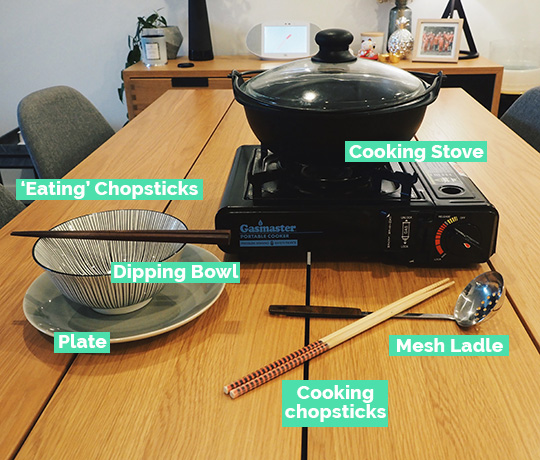
Soup Bases
This is the foundation of it all, so choose wisely. Any Asian supermarket worth their salt in Australia will have a hot pot aisle where you can find a variety of pre-made soup bases. These either come in pre-packaged soups or concentrated “cakes” that you just add water to.
If you’re a first-timer, opt for a mushroom or seafood base. If you love a bit of spice, sichuan chilli bases are perfect for hot pot – unlike “hot” chilli, sichuan chilli is peppery, packed with umami and is a “numbing” chilli that compliments fatty meats like wagyu and lamb beautifully.
Hot Pot soup base brands: Do your research
Everyone has a favourite brand of hot pot soup base, so I say try them all. Hai Di Lao and Little Sheep are solid brands that have been around for years and are readily available in Asian groceries around Australia, so they’re great places to start.
Some families like to create their own mix, starting with the chicken soup base and adding ingredients like aromatics (garlic, shallots, ginger), shitake mushroom, white radish… but honestly, the pre-made stuff is just as amazing and so much simpler.
One tip
If you are going for a pre-made soup, still start the stock with some fresh ingredients to add a little richness to get flavour from the first bite. Pop in some mushrooms, Chinese cabbage and a handful of aromatics like garlic and shallots. I also like to put in the ingredients that benefit from a longer time in the stock to soak up the flavour, like hard tofu, bean curd or Konnyaku knots to get the ball rolling.
Whichever soup you choose, keep the broth a little diluted to start – as the night goes on and more of the ingredients gets cooked in the soup, it will become richer and more flavourful naturally, so don’t start it off too salty.
Just like having extra gas canisters, have extra chicken stock or hot water on hand throughout the night to refill the soup as the meal goes on.
Dipping Sauces
If ever there is a place to experiment and have fun, this is it. There are no rules here, and if you go out for hot pot at a restaurant, many like to flaunt the large variety of ingredients they have on hand.
After a few sessions, you’ll find your personal blend, and no two sauces are ever the same. To get you started, here are a few basic ingredients that you can’t go wrong with. Pick a few from the list and mix and match throughout the session:
- Light soy sauce
- Shacha Sauce (aka Chinese BBQ sauce made from a blend of oil, garlic, shallots, chilies, and dried shrimp)
- Sesame paste or sesame oil
- Oyster sauce
- Chilli oil
- Shaoxing wine
- Toasted sesame seeds
- Chopped shallots/scallions
- Chopped chillies
Raw Eggs?
The final ingredient is not for everyone: raw eggs. Because of the heat of the meat when it comes out of the hot pot, dipping it in a sauce whipped through with a raw egg will cook the thin layer of egg, giving the meat a silkier texture while helping your sauce to cling to the meat better. It’s not for everyone though – you know your digestive system better than anyone else – and many people opt out of it.
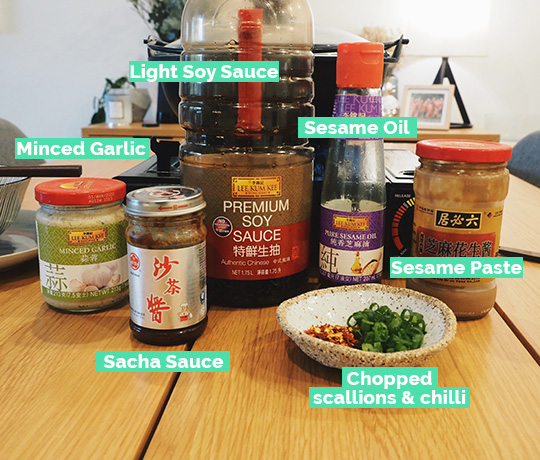
Meats
For hot pot, sliced meats are best if you’re not a vegetarian or vegan – they’re quick to cook and beautifully soak up the flavours of the broth. Buy these frozen at your local Asian supermarket and always get more than you think you need, because these cook down into small bite sizes.
Get a variety of meats – you’ll be surprised who doesn’t like lamb or eat beef – and they’re a great way to start building flavour in your dipping sauces.
Here are a few staples to include:
- Wagyu beef
- Lamb
- Pork belly
Chicken is less common because it can be risky, but if you would like to include it, opt for marinated breast or thigh and cook it for a little longer.
Kick off your hot pot with a round of meats first; not only is it ready in seconds, but the cooking the meat in the broth first starts to lend some richness and flavour that’ll benefit the other ingredients later.
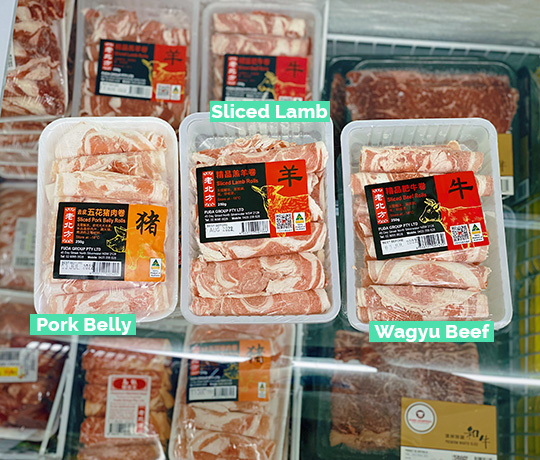
Seafood
This is a signature of Cantonese style hot pot – which is what I grew up with. Pop these in after the first round of meats and leave them in there to cook while you’re still enjoying the rolled wagyu for maximum time management, but again, it’s about building on the flavours of the broth.
For hot pot, frozen seafood is just fine, but being in Australia, we’re spoilt with beautiful seafood, so go for broke if you have a few spare dollars.
A few seafood classics include:
- Mussels
- Prawns
- Squid
- Salmon (sliced about 2cm in thickness)
- Scallops
For a touch of class, thinly-sliced abalone – often seen as a delicacy in Chinese culture – is a real treat. They’re quick to cook and all it needs is a little dash of soy to perfectly compliment its natural sweetness.
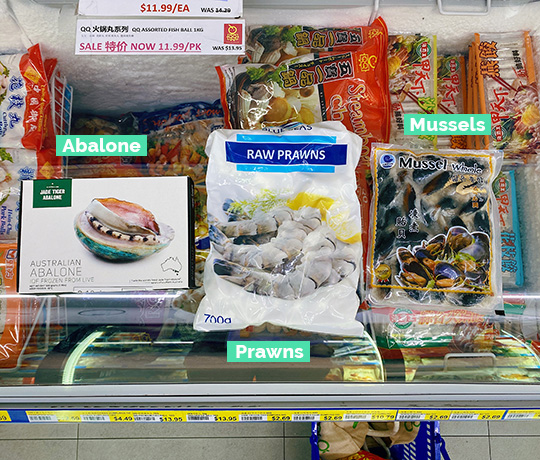
Fish and Meat Balls
In a sea of beautiful seafood and delicious sliced meat, I always go for the fish and meat balls. They may be cheap, but they taste a million dollars to me and I know I’m not alone.
They’re easy to cook, packed with flavour and I love their bitey, al dente texture. There are as many variety of fish balls, cuttlefish balls, and pork balls as you can imagine and there are always new inventions that are fun to try.
Just like soup bases, everyone has a favourite brand, but for me, it’s Aussie-made institution Hakka. Their fish cakes are legendary, and for hot pot, they have a whole range of bursting fish balls, “royal” pork balls (pork & mushroom) and more that will set you up for success.
Here are a few of my favourites that I always hoover up at hot pot:
- Fish cakes
- White fish balls
- Fried fish balls
- Royal pork balls
- Beef balls
- Bursting fish balls (fish balls with pork, shallots and other goodness)
One thing I definitely recommend is fresh fish paste. These can come in a packet frozen in your favourite Asian supermarket. But it’s “fresh” in that you need to shape them into fish balls yourself. Some Chinese fish mongers even pride themselves in making their own when it’s hot pot season. Just grab a spoon and scoop some into the broth to cook. It’s packed with flavour and the texture is a beautiful light al dente. Definitely worth a try.
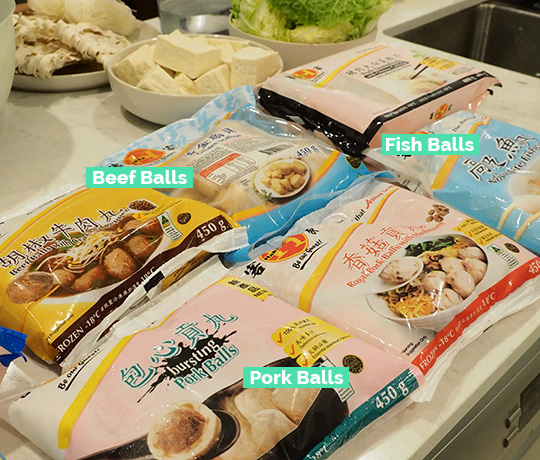
Noodles & Carbs
By now, your broth will have needed a bit of topping up with chicken stock or hot water. But should be deliciously rich and flavourful from the previous ingredients. This is the perfect time to cook our carbs to soak up this broth.
You don’t need too much of these because hot pot is more about the ingredients than carbs. But for those with a bigger appetite, including some noodles will make sure everyone’s full.
Go ahead and pop in your favourite noodles and play around with the texture.
Some suggestions:
- Instant ramen eg. Nissin (just the noodles, not the flavour sachet of course)
- Knife-sliced/handcut noodles (Dao Xiao Mian, for some chewey gluten textures)
- Shanghainese rice cakes (oh man, these are the best!)
- Japanese udon
- Vermicelli or glass noodles
Another must-have is dumplings. Once again, frozen dumplings are absolutely perfect for hot pot and it just beautifully soaks up the flavours in the sauce. Opt for a simpler filling like pork and watercress – there’s already plenty of flavour.
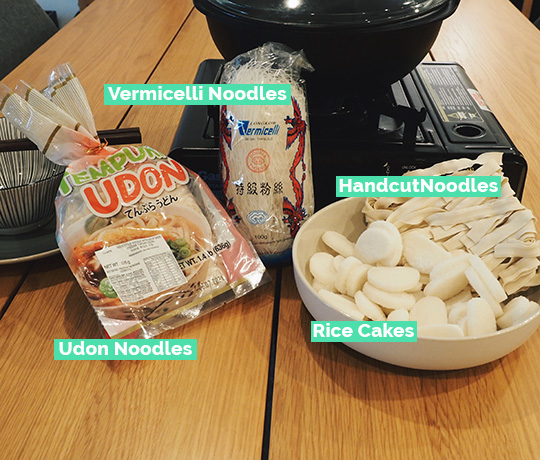
Veggies & Tofu
Once all the beautiful flavours have developed, it’s time to finish off with some fresh veggies. For our vegetarian friends, there are so many ingredients here you can easily do a hot pot that is just for veggies or vegans. That’s the beauty of hot pot. It can be tailored to you and your party each time.
Traditionally, veggies are eaten last, but be aware. The longer you wait, the oiler the soup becomes from the cooking process. Leafy veggies in particular soak up more of the soup and the oily surface. So if you leave it too long, you’ll end up with an oily mouthful.
Veggie Recommendations
On the other hand, there are some veggies that benefit from a longer cooking time to soak up the flavour, so I’ll break up my recommendations here as a guide:
- Quick-cooking leafy vegetables:
- Chinese broccoli/Gia Lan)
- Chinese cabbage/Wombok
- Spinach
- Baby bok choy
- Kale
- Bean sprouts
- Leave-in vegetables:
- Mushrooms (go for a mixture to add texture- shiitake, king oyster mushrooms, swiss mushrooms, enoki)
- Firm tofu (any other kind will melt or break apart too easily)
- Bean curd sheets (fried or fresh – these are great for soaking up the flavours of the broth in the end)
Secret Ingredient : Konnyaku knots
One ingredient I always add in are Konnyaku knots. Konnyaku is part of the taro/yam family, and here it is ground into a flour, then spun into threads like vermicelli, and tied into knots. They come pre-packaged in water which should be drained before serving. Konnyaku is flavourless on it’s own. So throw it in from the start and they stay in the pot without breaking apart or losing its texture. It beautifully soaks in the flavours of the broth and delivers a beautiful burst of flavour with a satisfying bite.
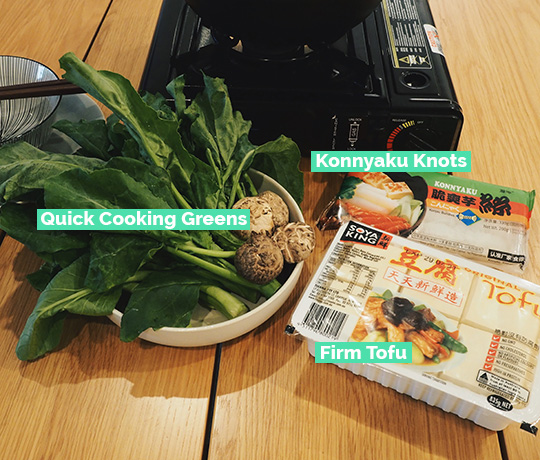
Hot Pot Etiquette
Ok, so I said there are no rules when it comes to Hot Pot, but there are a few common etiquettes to observe for first-timers. Remember, every family’s hot pot traditions are slightly different. So follow their lead, but these tips will keep you out of trouble:
- Don’t double-dip in the soup. Pandemic or not, it’s good to have a pair of cooking chopsticks and a pair you use to eat to avoid spreading germs or mixing cooked and raw ingredients. Better yet, put the raw ingredients in your strainer and cook it from there. But don’t worry. Everyone starts with this etiquette but you’ll soon forget and mix your utensils up. Just do your best.
- Finder’s keepers. Periodically add ingredients in the soup like mussels or fish balls as you like, but it’s always polite to add more than just your portion. As someone will always want to try some (and it’s honestly part of the fun). So if you find something in the broth that you didn’t put in, ask around if anyone’s waiting for something to cook. Otherwise it’s all fair game. Enjoy it and grab something else to pay it forward.
- Stand up. Hot pot is more fun if you can see what you’re cooking. Or if you spot a surprise ingredient that you really want to try, so don’t be shy. That’s what your little dipping bowl or plate is for. Grab it in one hand, get some height and go fishing for goodness.
- Don’t cross-contaminate soup bases. OK, this is key if you have people who don’t eat chilli or have a vegetarian pot going. Don’t mix cooking ladles from one pot with another, or everything will mix to become one chilli (or diluted) mess. There’s nothing wrong with sampling other soup bases – in fact, it’s encouraged – just use another spare ladle.
Stop Reading
That’s it! This guide is certainly comprehensive. but at the end of the day, hot pot – like life – is best experienced, not just read about.
So head to your local Asian supermarket’s hot pot aisle. Make sure you have a few of everything from each category above, gather your favourite people, and have some fun this winter!





















